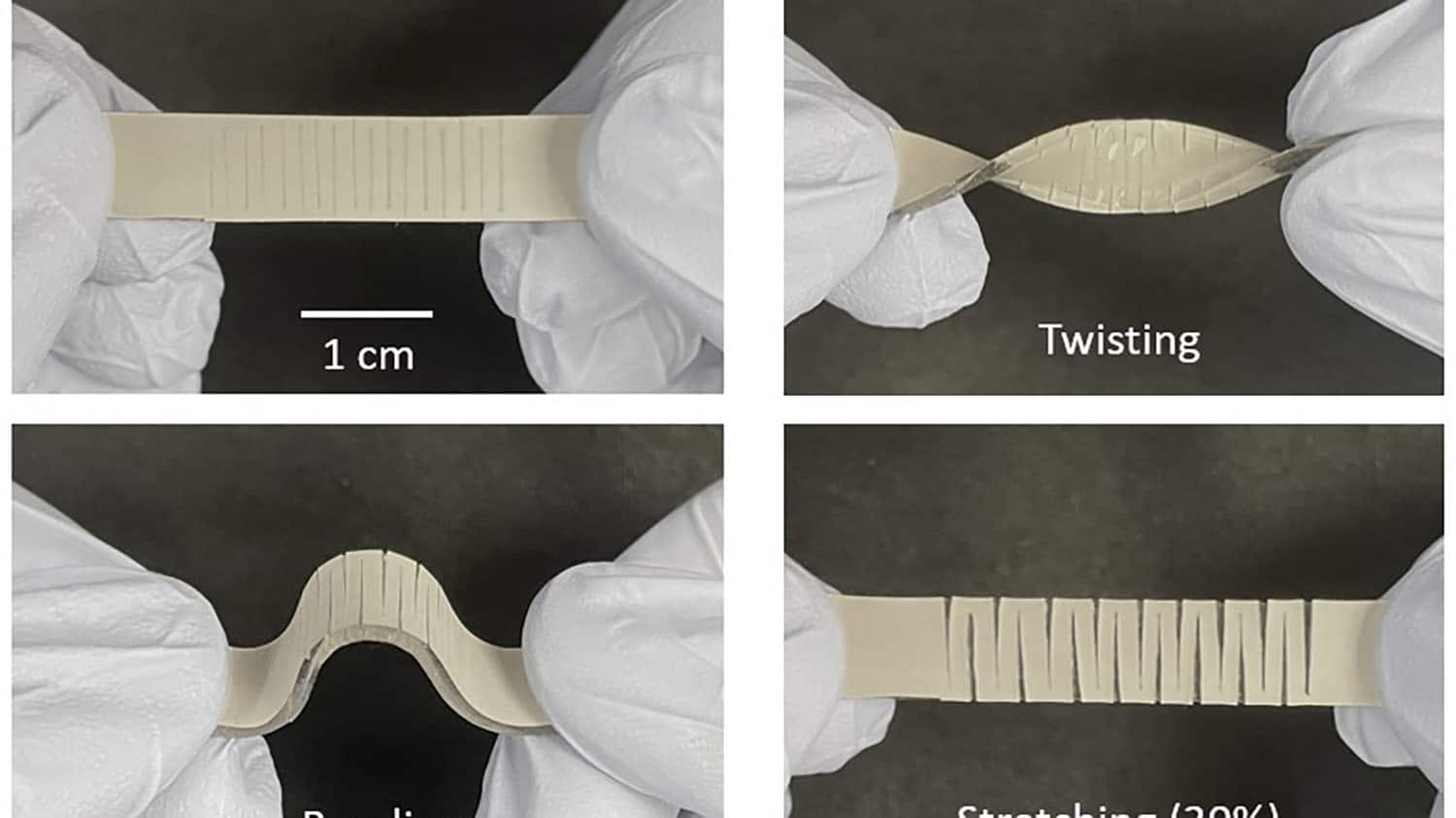Researchers Demonstrate New Strain Sensors in Health Monitoring, Machine Interface Tech

For Immediate Release
Researchers at North Carolina State University have developed a stretchable strain sensor that has an unprecedented combination of sensitivity and range, allowing it to detect even minor changes in strain with greater range of motion than previous technologies. The researchers demonstrated the sensor’s utility by creating new health monitoring and human-machine interface devices.
Strain is a measurement of how much a material deforms from its original length. For example, if you stretched a rubber band to twice its original length, its strain would be 100%.
“And measuring strain is useful in many applications, such as devices that measure blood pressure and technologies that track physical movement,” says Yong Zhu, corresponding author of a paper on the work and the Andrew A. Adams Distinguished Professor of Mechanical and Aerospace Engineering at NC State.
“But to date there’s been a trade-off. Strain sensors that are sensitive – capable of detecting small deformations – cannot be stretched very far. On the other hand, sensors that can be stretched to greater lengths are typically not very sensitive. The new sensor we’ve developed is both sensitive and capable of withstanding significant deformation,” says Zhu. “An additional feature is that the sensor is highly robust even when over-strained, meaning it is unlikely to break when the applied strain accidently exceeds the sensing range.”
The new sensor consists of a silver nanowire network embedded in an elastic polymer. The polymer features a pattern of parallel cuts of a uniform depth, alternating from either side of the material: one cut from the left, followed by one from the right, followed by one from the left, and so on.
“This feature – the patterned cuts – is what enables a greater range of deformation without sacrificing sensitivity,” says Shuang Wu, who is first author of the paper and a recent Ph.D. graduate at NC State.
The sensor measures strain by measuring changes in electrical resistance. As the material stretches, resistance increases. The cuts in the surface of the sensor are perpendicular to the direction that it is stretched. This does two things. First, the cuts allow the sensor to deform significantly. Because the cuts in the surface pull open, creating a zigzag pattern, the material can withstand substantial deformation without reaching the breaking point. Second, when the cuts pull open, this forces the electrical signal to travel further, traveling up and down the zigzag.
“To demonstrate the sensitivity of the new sensors, we used them to create new wearable blood pressure devices,” Zhu says. “And to demonstrate how far the sensors can be deformed, we created a wearable device for monitoring motion in a person’s back, which has utility for physical therapy.”
“We have also demonstrated a human-machine interface,” Wu says. “Specifically, we used the sensor to create a three-dimensional touch controller that can be used to control a video game.”
“The sensor can be easily incorporated into existing wearable materials such as fabrics and athletic tapes, convenient for practical applications,” Zhu says. “And all of this is just scratching the surface. We think there will be a range of additional applications as we continue working with this technology.”
The paper, “Highly Sensitive, Stretchable, and Robust Strain Sensor Based on Crack Propagation and Opening,” is published in the journal ACS Applied Materials & Interfaces. The paper was co-authored by Katherine Moody, a Ph.D. student at NC State; and by Abhiroop Kollipara, a former undergraduate at NC State.
The work was done with support from the National Science Foundation, under grant number 2122841; the National Institutes of Health, under grant number R01HD108473; and the U.S. Department of Defense, under grant number W81XWH-21-1-0185.
-shipman-
Note to Editors: The study abstract follows.
“Highly Sensitive, Stretchable, and Robust Strain Sensor Based on Crack Propagation and Opening”
Authors: Shuang Wu, Katherine Moody, Abhiroop Kollipara and Yong Zhu, North Carolina State University
Published: Dec. 22, 2022, ACS Applied Materials & Interfaces
DOI: 10.1021/acsami.2c16741
Abstract: Soft and stretchable strain sensors have been attracting significant attention. However, the trade-off between the sensitivity (gauge factor) and the sensing range has been a major challenge. In this work, we report a soft stretchable resistive strain sensor with an unusual combination of high sensitivity, large sensing range, and high robustness. The sensor is made of a silver nanowire network embedded below the surface of an elastomeric matrix (e.g., poly(dimethylsiloxane)). Periodic mechanical cuts are applied to the top surface of the sensor, changing the current flow from uniformly across the sensor to along the conducting path defined by the open cracks. Both experiment and finite element analysis are conducted to study the effect of the slit depth, slit length, and pitch between the slits. The stretchable strain sensor can be integrated into wearable systems for monitoring physiological functions and body motions associated with different levels of strain, such as blood pressure and lower back health. Finally, a soft three-dimensional (3D) touch sensor that tracks both normal and shear stresses is developed for human–machine interfaces and tactile sensing for robotics.


